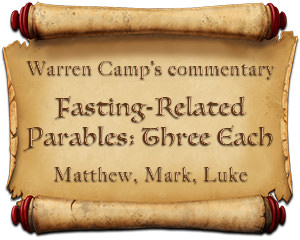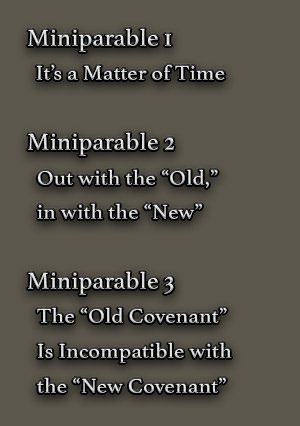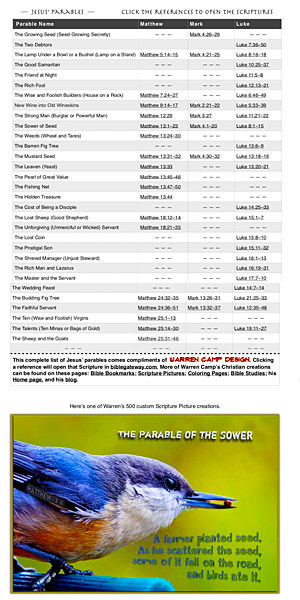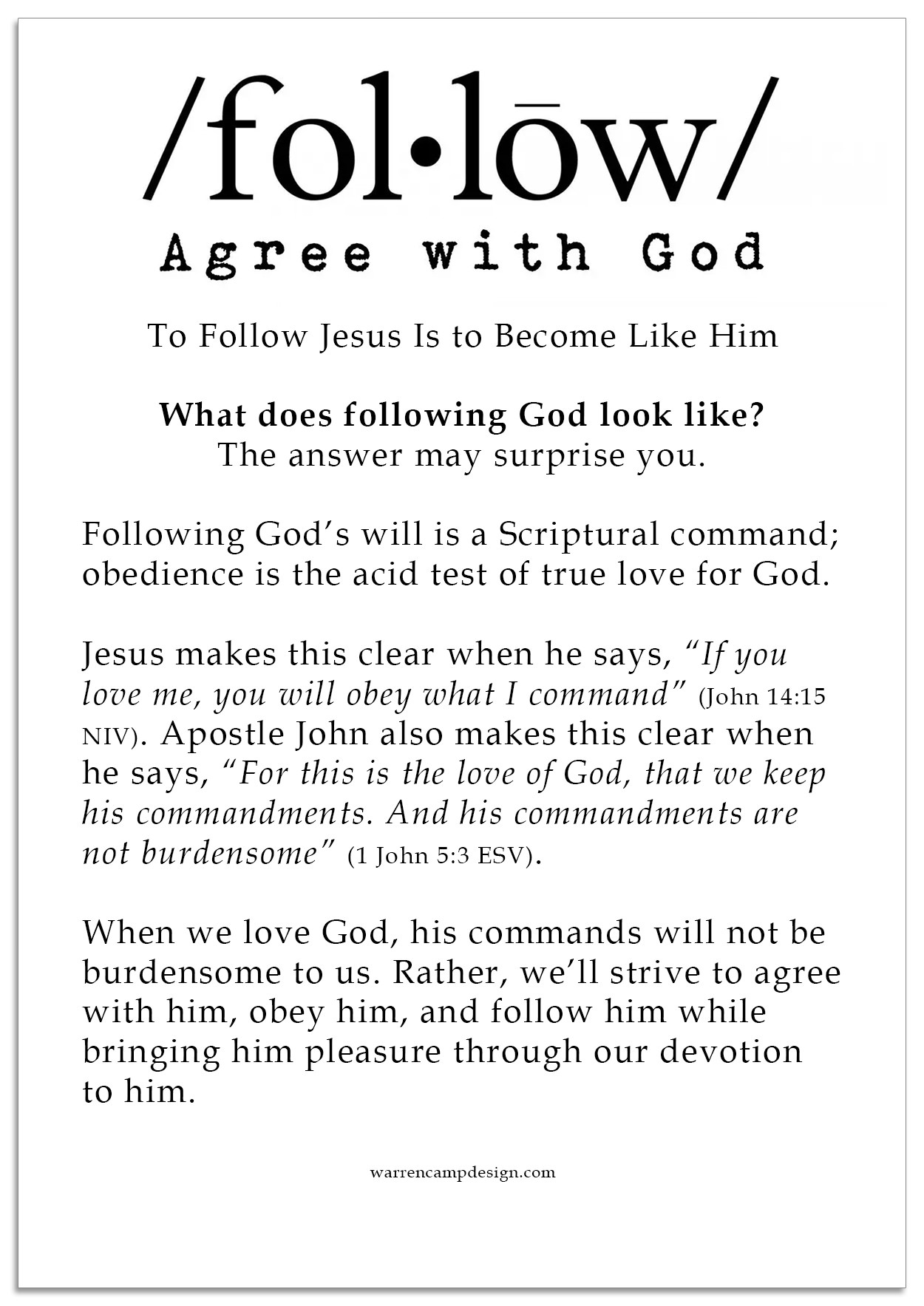Jesus not only befriends tax collectors and sinners, he also eats and drinks with them. In all three miniparables about the appropriate practice of fasting, John the Baptizer’s disciples and the Pharisees don’t question Jesus’ behavior. They do, however, ask why his disciples don’t fast.
All three miniparables follow a question asked about fasting, specifically, “Why don’t Jesus’ disciples fast?” Although Jesus’ answer addresses fasting, he uses this question to teach a broader truth: With his coming, everything ought to change.
— Preview —



Click the list or the “bird” to enlarge and use Warren’s list of forty-four of Jesus’ parables (a PDF file with links to Scriptures).
par•a•ble [noun] a simple story used to illustrate the meaning of or a moral or spiritual lesson, as told by Jesus in the gospels
synonyms: allegory, moral story/tale, fable
Jesus’ Three Fasting-Related Parables:
(2) “Patching an Old Garment,” and
(3) “Pouring Wine into Wineskins”
Matthew 9:14–17; Mark 2:18–22, Luke 5:33–39
The NIV titles all three gospel presentations of this collection of like-kind miniparables as “Jesus Questioned About Fasting.” Each synoptic gospel informs us that it was John the Baptizer’s disciples (and the Pharisees) who questioned Jesus about fasting. John had two goals: to (1) encourage people to repent of their sin and (2) prepare them for Christ’s coming. John’s message was clearheaded, which stimulated him and his followers to fast. While the act of fasting is an outward sign of humility and a sincere regret for sin, the act — then and today — is meant to clear one’s mind while keeping the spirit alert. Clearly, fasting can empty our body of food while repentance can empty our life of sin.
In the first miniparable, Jesus compares his time with his disciples to a wedding feast in which he’s the bridegroom and they’re his friends and/or guests. Doing so, Jesus effectively shines the spotlight directly on himself, whom the Pharisees had been attempting to challenge and discredit since they saw Jesus as the one who’d been breaking the Pharisees’ traditions and self-generated and -imposed rules.
Effectively addressing the question, “How is it that John’s disciples and the disciples of the Pharisees are fasting, but yours are not?” (Mark 2:18b), all three of Jesus’ responsive parables tell the questioners that, with his arrival as Messiah, things must change; their old rules and traditions no longer applied. People needed to accept and adopt his new rules that originated directly from Father God’s kingdom.
It’s likely that Jesus’ three-part answer was intended to insult the Pharisees, whose level of rage against Jesus had already grown significantly. Regarding miniparable 1, Jesus explained that he was the present Messiah (referred in those days to “the bridegroom”); as a result, his disciples (and the Pharisees) didn’t need to fast. Nevertheless, Jesus recognized a future time when he wouldn’t be with them; then they’d have good reason to grieve and fast. Miniparables 2 and 3 further reinforce the transitioning from old to new in the coming days and generations.
Miniparable 1: The Mourning of the Bridegroom’s Guests
It’s a Matter of Time
Then John’s disciples came and asked him, “How is it that we and the Pharisees fast often, but your disciples do not fast?” (Matt. 9:14)
It’s essential that these parables (and all Scriptures for that matter) are put into context so we readers can correctly understand and appreciate their relevance and meaning. People of that day were disturbed when they saw or learned that Jesus intentionally chose to eat with sinners (9:11). Many Israelites, especially religious leaders, believed that it was essential to make every effort to avoid ungodly people — sinners — never allowing themselves to eat in their presence. Others believed that holiness meant carefully following and practicing religious practices of self-discipline, such as fasting. To give the people a new perspective on who he was and what new rules and conventions needed to be adopted, Jesus spoke three illustrative parables about living suitably in a God-honoring manner, not following old, self-adopted traditions. For those sinners who’d learned well from Jesus’ teachings and sought and received redemption in their new lives, it was most fitting to celebrate rather than fast.
The Old Testament only commanded people to fast one day out of the year: the Day of Atonement (see Leviticus 16:29–34). But people also chose to fast at other times and occasions. When one fasted, it was usually an expression of sorrow, perhaps for a lost life or as an act of repentance for committed sin. And fasting was usually associated with prayer; there were times when the entire nation chose to fast and pray together. With regard to the Pharisees, first-century Jews regarded fasting as a mark of piety, not repentance. They were known to have fasted on Mondays and Thursdays, considering this to be a religious act of devotion, often going to great lengths to make sure that other people saw them fasting. Jesus described those Pharisees as purposely looking somber and sad, disfiguring their faces to show men they were fasting (Matthew 6:16–18).
Jesus had little concern for Israelite religious leaders’ traditions and customs. It’s also worth noting that such fasting wasn’t required by Mosaic Law; it was an important element of Israel’s religious historical convention. Regarding the overt fasting effort that Jesus undertook in the wilderness (4:1–3), Jesus, here (9:14), refrains from regarding himself as the ultimate faster. Instead, he directs his listeners’ attention to his three “not old but new” miniparables, suggesting that everything is to change at an appropriate time. He emphasized fasting to be undertaken with the correct, righteous motives.
As he’d done often, Jesus answered John’s disciples’ question by asking them a question. It wasn’t to avoid giving them an answer but to make a point. In Mark 2:18, the people asked him, “How is it that John’s disciples and the disciples of the Pharisees are fasting, but yours are not?” Our Lord responded by saying that fasting was inherently proper and he didn’t denounce the Pharisees for taking additional fasts. Instead, Jesus viewed their fasts as taking place during the wrong time. He asked John’s disciples a rhetorical question: “How can the guests of the bridegroom fast while he is still with them?” (v. 19a). The answer is obvious — they can’t, because a wedding is a time of feasting, not fasting! Weddings are to be filled with joy and celebration when family and friends gather to enjoy music and song. Fasting, on the other hand, is to be done during times of sorrow, pleading, or self-denial. After all, no one would expect wedding banquet guests to fast while the bridegroom was with them amid the merriment.
Throughout the Bible, the “bride” image is often used for God’s people while the “groom” represents God who loves his people. Regarding wedding banquet tradition, wedding ceremonies lasted seven days and nights. They were big village events with numerous people joining in gala festivities. It wasn’t appropriate or expected for groomsmen or the groom’s guests to fast until the magnificent wedding banquet had concluded. Here’s how Jesus responded to those who’d asked him, “How is it that we and the Pharisees fast often, but your disciples do not fast?” (v. 14).
Jesus answered, “How can the guests of the bridegroom mourn while he is with them? The time will come when the bridegroom will be taken from them; then they will fast (Matt. 9:15).
It’s a matter of time. The disciples of bridegroom Jesus had no need to fast in preparation of his coming because he was already home with them. This first of three responses assumes that God’s kingdom isn’t a funeral wake requiring mourning; instead, it’s a joyous wedding party. No one wants grim-faced fasters casting a dark cloud on a joyous celebration. When such joy is present, it’s inappropriate to fast, albeit impossible.
Jesus declares in this miniparable that he’s the bridegroom! He’s the Messiah for whom Israel has been waiting for centuries. Back then, it was appropriate for the Israelites to fast before and during their wait for the Messiah’s appearance. But, when Jesus’ arrived, everyone was to rejoice because the bridegroom had finally come. But as Mark’s passage below reveals, Jesus suggests that there would be a time — when the bridegroom “will be taken from them” — making it appropriate, then, to mourn (a la Matthew’s version) and fast (a la Mark and Luke); it references his coming death. Thankfully, his death wouldn’t become a permanent condition. Instead, Christ Jesus’ resurrection would turn all subsequent grief and sorrow into outright joy, amen.
19Jesus answered, “How can the guests of the bridegroom fast while he is with them? They cannot, so long as they have him with them. 20But the time will come when the bridegroom will be taken from them, and on that day they will fast (Mark 2:19–20).
Don’t miss the significance of Jesus’ comparing himself to a bridegroom. Doing so, he makes an absolute claim to deity. After all, Father God was the bridegroom who’d rejoice over his bride — the people of ancient Israel (Isaiah 62:5).
Miniparable 2: Patching an Old Garment
Out with the “Old,” in with the “New”
Jesus’ second and third responses draw on everyday life metaphors to illustrate the magnitude of Jesus’ teaching about God’s kingdom. Namely, the old is incompatible with the new.
“No one sews a patch of unshrunk cloth on an old garment. Otherwise, the new piece will pull away from the old, making the tear worse” (Matt. 9:21).
Remember that Jesus had continually been accused of not keeping the rules and traditions that religious leaders had promoted and that the crowd insisted he follow. It’s important to also realize that, according to all three gospel accounts of these miniparables, Jesus spoke them to a mixed crowd made up of “John’s disciples” (Matthew 9:14), “some people” (Mark 2:18), and “the Pharisees and the teachers of the law” (Luke 5:30). Despite the onerous burdens the Pharisees created with their interpretations, the common people held a favorable view of them. So, it makes sense why they’d question not only why Jesus’ disciples didn’t fast as John’s disciples did, but also why they themselves didn’t fast as the Pharisees did.
It’s likely that John the Baptizer’s followers practiced fasting, however, their’s was done for a different purpose. John’s message was one of repentance prior to Christ’s coming, unlike the manner and purpose of fasting adopted by the Pharisees. John’s disciples fasted to express their changed ways, their repentance for their sins, knowing that Christ would soon come to offer them salvation. Looking at what each gospel writer presents in this passage, it’s possible that John’s disciples thought it appropriate to repair the old torn garment (i.e., Judaism) by sewing onto it a patch of new “unshrunk” cloth (i.e., John’s repentance message and Jesus’ good news about God’s kingdom). The old torn garment represented the self-righteous ritualism of the Pharisees, scribes, and teachers of the Law.
Jesus used an illustration of an unfinished, unshrunk piece of cloth that was to be used to mend an old garment that was torn. While most of our clothing comes preshrunk today, conditions were different in Jesus’ time. So, if you have an older garment that’s been washed multiple times, it’s already shrunk to the fullest extent. However, if a hole develops in your garment and you patch it by sewing over the hole a piece of unshrunk cloth, your garment won’t shrink after you wash it, but the new patch will certainly shrink and tear a larger hole in your garment. The implication that Jesus made suggests that something new, not yet unfinished, would be incompatible with something old, which, in this miniparable’s case, had been damaged or become torn. He used a new, unfinished cloth to represent his Kingdom message of the New Covenant of Christ Jesus being Messiah; the old torn garment represents the then-current condition of Judaism.
Because the New Covenant hadn’t been fully revealed to Israel and the non-Jewish Gentiles, it’s concept couldn’t be easily and completely understood and appreciated. The Old Covenant, based on Mosaic Law and the Prophets, had become damaged, destroyed, and incompetent by those religious leaders of the day who honored and obeyed their self-made rules, regulations, and traditions. Sadly, the Pharisees and teachers of the Law rejected Lord Jesus’ righteous claim that he was indeed the prophesied Messiah.
It was impossible for Israel’s religious elite to repair their old, damaged garment by simply sewing on and applying a new, unfinished cloth patch to the clothing item. Doing so would definitely create something far more damaged and useless than the original item, “making the tear worse” (v. 16b).
Miniparable 3: Pouring Wine into Wineskins
The “Old Covenant” Is Incompatible with the “New Covenant”
37“And no one pours new wine into old wineskins. Otherwise, the new wine will burst the skins; the wine will run out and the wineskins will be ruined.38No, new wine must be poured into new wineskins. 39And no one after drinking old wine wants the new, for they say, ‘The old is better’” (Luke 5:37–39).
Today, as well as in Jesus’ day, grapes begin the fermenting process immediately after they’ve undergone pressing or stomping. Throughout time, it’s been shown conclusively that new wine undergoes continual fermentation, which includes a progressive increasing of pressure inside a wine container. Consequently, in biblical times, adding new wine to an old wineskin that was typically made of sheep or goat leather would cause catastrophic bursting of the leather bag and a disappointing loss of valuable wine.
Regarding the applicability of wineskins, over time, an old wineskin, when new wine is poured into it, becomes significantly stretched when the new wine ferments and expands therein; old brittle bags burst as a result of the natural fermenting process. Because old wineskins had previously been fully stretched, they’d be bound to burst when filled with new wine that would surely thicken and swell as it aged. Nevertheless, it was possible for old wineskins to be reconditioned and softened by soaking them in water for a period of time. Thereafter, their presumed brittleness could be converted to a pliable condition that would be able to successfully hold new wine. But an intentional reconditioning effort would have been required to make brittle leather skins flexible.
Comparing the old and new covenants through Jeremiah, God spoke: “The time is coming when I will make a new covenant” (Jer. 31:31–34). In this miniparable, Jesus is saying, “The time has come.” God’s new covenant is based on his Son, Jesus, and his shed blood. He died to redeem our sin debt; those of us who believe and follow Jesus will indeed be redeemed. Sadly, the Pharisees routinely insisted on maintaining and living by the old covenant. They’d become as rigid as old, brittle wineskins. They weren’t able or willing to believe that Jesus was the prophesied Messiah; they remained insistent on living strictly according to man-made concepts, rules, and rituals.
All three miniparables effectively provide this universal message about the kingdom of God: “The old manner and traditions of fasting are inappropriate, given the righteousness of the new kingdom that had come with the arrival of Christ Jesus the Messiah.” The old is incompatible with the new. The new wine — the gospel of Jesus — would overtake and disrupt the aims and traditional practices of those people trapped by rigid, impersonal, religious routines. This new kingdom message was designed to bring growth and expansion while distancing itself from the old dried-out, inflexible system and rituals of Judaism. Jesus was teaching all who heard these three miniparables that he hadn’t come to reform Judaism but to promote and demonstrate essential biblical truths that hadn’t yet been revealed to them.
Make no mistake about what Jesus is telling us, his readers, of these miniparables: Our lives must change to accommodate Christ. Look at v. 22b that follows this introductory statement in v. 22a: “No one pours new wine into old wineskins.” He finishes by saying, “No, he pours new wine into new wineskins.” In effect, none of us can follow Christ while continuing to live the same way we lived before we chose him to be our Lord. A sinner can feel reasonably happy in his or her sin; but, a true believer will never be happy living in sin! And that’s a good thing. God doesn’t leave any of us to wallow in our sin. Why not? Because our old self is incompatible with our new self. That’s why each of our lives must change to accommodate the ways of Christ Jesus. He not only wants to free us from our old ways, he wants to lead and direct us into new ways of living.
Jesus makes it clear in each gospel’s “Jesus Questioned About Fasting” passage: The new covenant is incompatible with the old. The time of the old covenant is over; it’s finished. We learn from reading the book of Hebrews that the old covenant is “obsolete; and what is obsolete and outdated will soon disappear” (Heb. 8:13). The new covenant that Jesus brings is incompatible with the old covenant. He didn’t come to earth to patch up an old system that had no resemblance to God’s revolutionary rule. His new message can only be successfully deposited in a person’s old heart, once it’s been reconditioned and made soft, pliable, and ready to expand itself to accept new possibilities and opportunities in the lives of those who’ll continually grow within God’s kingdom. It’s the purity of the heart that matters most!
It Makes You Wonder . . .
• What point is Jesus making with each story? (1) mourning or fasting while the bridegroom is present; (2) sewing a new patch onto an old garment; and (3) pouring new wine into an old wineskin
• Why did John’s disciples and the Pharisees fast (Lev. 16:29, 31; 23:27, 29, 31)?
• Why did Jesus’s disciples not fast?
• How is Jesus and his teaching like the unshrunk cloth and new wine (Mark 2:21–22)?
• What is your “new wine”? Your “old wineskins”?
• In what ways does following Christ require you to replace old habits with new ones?
• Why do some of us resist making new changes? What could help facilitate making a hearty old-to-new change in whom you follow?
“And no one after drinking old wine wants the new, for they say, ‘The old is better’” (Luke 5:39).



